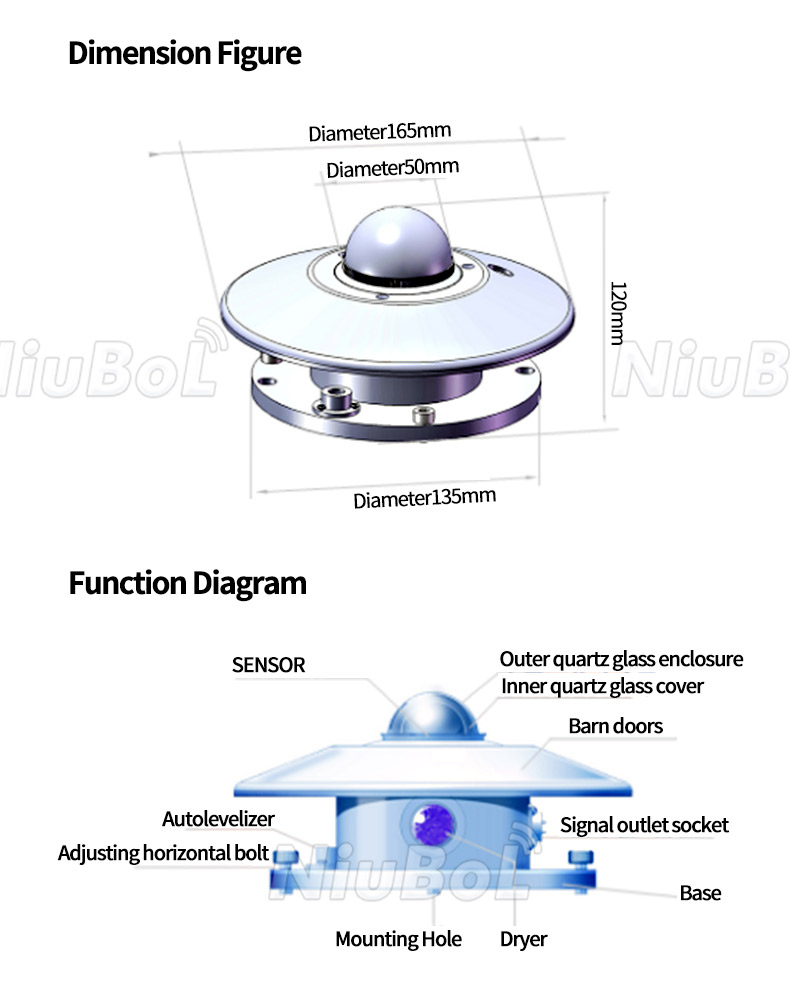

— Blogs —
—Products—
 Consumer hotline +8618073152920
Consumer hotline +8618073152920 WhatsApp:+8615367865107
Address:Room 102, District D, Houhu Industrial Park, Yuelu District, Changsha City, Hunan Province, China
Product knowledge
Time:2024-01-14 20:11:38 Popularity:686
Pyranometers are instruments used to measure the total solar radiation received by a surface. They are designed to capture and quantify the amount of solar energy that reaches a specific location, regardless of the direction or wavelength of the radiation. Pyranometers typically consist of a sensor, housing, and electronics for data collection and processing.
The sensor in a pyranometer is a thermopile or photovoltaic device that absorbs solar radiation and converts it into an electrical signal proportional to the incoming radiation intensity. The housing protects the sensor from external factors such as wind, rain, and temperature variations. It is designed to minimize the influence of these factors on the accuracy of the measurements.
Pyranometers are specifically calibrated to measure the solar radiation within the spectral range of approximately 300 to 3000 nanometers, covering the entire solar spectrum. This allows them to accurately measure global, diffuse, and direct solar radiation.
The output of a pyranometer is usually in the form of millivolts (mV), representing the electrical signal generated by the sensor. This signal can be further processed or converted to other units such as watts per square meter (W/m²) or kilowatt-hours per square meter (kWh/m²) to express the solar radiation intensity.
The use of Pyranometer in agriculture is mainly for measuring solar radiation, which in turn helps to understand and study the light conditions to which crops are exposed. By using the Pyranometer, agricultural scientists and farmers can obtain accurate data on solar radiation to assess the light conditions of their crops and take appropriate measures to optimize light and improve crop yield and quality.

Specifically, the Pyranometer can help agriculturalists understand the following aspects:
1. Crop growth monitoring: By using Pyranometers to measure the amount of solar radiation received by crops, farmers and agricultural professionals can understand the light conditions of the environment in which crops are located. This helps to monitor the growth process of crops, understand the efficiency of photosynthesis and predict crop yields. By comparing solar radiation data from different locations, it is also possible to assess the types of crops and cropping practices that are appropriate for different areas.
2. Irrigation management: Solar radiation is an important factor influencing plant transpiration and water requirements. By using Pyranometers to measure solar radiation, farmers can better understand the transpiration rate and water requirements of their crops and manage irrigation accordingly. This helps to avoid over- or under-irrigation, optimize water use and improve crop productivity.
3. Greenhouse management: Plants in greenhouses often require adjustments in light conditions to promote growth. By using Pyranometers to measure the amount of solar radiation inside the greenhouse, farmers can control and adjust the greenhouse shading, lighting or ventilation system to provide the right light conditions. This helps to optimize plant growth, improve yield and quality, and save energy costs.
4. Crop ecosystem studies: Solar radiation is one of the important factors affecting agro-ecosystems. By using Pyranometers to measure the amount of solar radiation in farmland, researchers can understand how factors such as photosynthetic efficiency, water evaporation rate, soil temperature, etc. affect crop ecosystems. This can help optimize farmland management strategies, improve productivity, and reduce resource waste.
5. Monitoring environmental changes: Pyranometer can also be used to monitor environmental changes, such as the impact of climate change on crops. Through long-term data accumulation and analysis, agricultural personnel can understand the impact of climate change on crop growth and yield, and take appropriate adaptation measures.
In summary, Pyranometers can be used in agriculture to monitor crop growth, adjust irrigation management, optimize greenhouse environments, and study crop ecosystems. By providing accurate solar radiation data, they provide important information for farmers and researchers to better understand and manage light conditions for crops to maximize yield and quality.
NBL-W-HPRS-Solar-Radiation-Sensor-Instruction-Manual-V3.0.pdf
NBL-W-SRS-Solar-radiation-sensor-instruction-manual-V4.0.pdf
Related recommendations
Sensors & Weather Stations Catalog
Agriculture Sensors and Weather Stations Catalog-NiuBoL.pdf
Weather Stations Catalog-NiuBoL.pdf
Related products
 Combined air temperature and relative humidity sensor
Combined air temperature and relative humidity sensor Soil Moisture Temperature sensor for irrigation
Soil Moisture Temperature sensor for irrigation Soil pH sensor RS485 soil Testing instrument soil ph meter for agriculture
Soil pH sensor RS485 soil Testing instrument soil ph meter for agriculture Wind Speed sensor Output Modbus/RS485/Analog/0-5V/4-20mA
Wind Speed sensor Output Modbus/RS485/Analog/0-5V/4-20mA Tipping bucket rain gauge for weather monitoring auto rainfall sensor RS485/Outdoor/stainless steel
Tipping bucket rain gauge for weather monitoring auto rainfall sensor RS485/Outdoor/stainless steel Pyranometer Solar Radiation Sensor 4-20mA/RS485
Pyranometer Solar Radiation Sensor 4-20mA/RS485
Screenshot, WhatsApp to identify the QR code
WhatsApp number:+8615367865107
(Click on WhatsApp to copy and add friends)